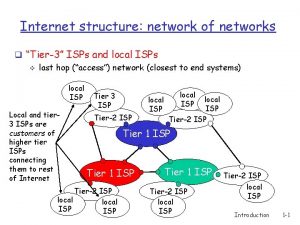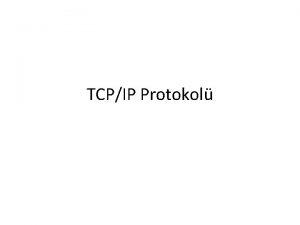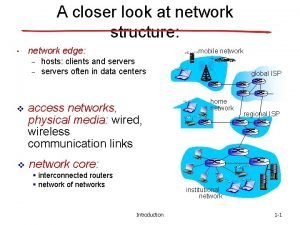Conflict in the Networks of Networks How Internet












- Slides: 12

Conflict in the Networks of Networks: How Internet Service Providers Have Shifted From Partners to Adversaries A presentation at the 2016 Annual Scientific Seminar on the Economics, Law and Policy of Communications Media: Competition and Regulation in Infrastructure and Digital Markets European University Institute, Florence, ITALY March 18, 2016 Rob Frieden, Pioneers Chair and Professor of Telecommunications and Law Penn State University rmf 5@psu. edu Web site : http: //www. personal. psu. edu/faculty/r/m/rmf 5/ Blog site: http: //telefrieden. blogspot. com/

First Four Phases in Internet Development 1) Incubation--government as anchor tenant and underwriter, first through the United States Defense Department and later through the United States National Science Foundation along with research institutes throughout the world (1980 s-1995); 2) Privatization--governments eliminate financial subsidies obligating contractors to assess whether and how to operate commercially (1995 -1998); 3) Commercialization—private networks proliferate as do ventures creating software applications and content that traverse the Internet. The “dotcom boom” triggers excessive investment and overcapacity (1998 -2001); and 4) Diversification—after the dotcom bust and market re-entrenchment, Internet survivors and market entrants expand the array of available services and ISPs offer diversified terms, conditions and rates, including price and quality of service discrimination needed by “mission critical” traffic having high bandwidth requirements, e. g. , full motion video content. ISPs and even content providers can use deep packet inspection to identify traffic for “better than best efforts” routing and other forms of prioritization at one extreme and blockage/throttling at the other. 2

Fifth Phase in Internet Development n Widespread diffusion of broadband infrastructure and increasing consumer demand for anytime, anywhere access to IPTV content. n Market entry by Content Distribution Networks whose business plan contemplates far more downstream data delivery requirements not offset by upstream carriage. n Widespread migration from reliance on only 2 interconnection and compensation models: 1) peering; 2) transit. n Increasing disputes over interconnection and compensation terms; claims that last km. ISPs abuse bottleneck control. 3

Less Cooperation In the current Internet generation, commercial exigencies (like the need to invest in more bandwidth) and the elimination of gov’t subsidies create incentives for profit maximization and identifying who has triggered higher service costs (cost causation). ISPs serving the last kilometer will seek to erect a double-sided platform with demand for payments from upstream ISPs and content providers in addition to downstream broadband subscribers. Retail ISPs may try to ration capacity, maximize revenues from both sides and offer “better than best efforts” traffic prioritization/specialized networks. With two sources of revenues available, Retail ISPs can offer end users new subsidized (free-rider) access such as “zero rating” and “sponsored data” much like credit card companies offering no annual fee options. Commercially-driven interconnection and compensation negotiations can benefit consumers without harming competition. However, the potential exists for Retails ISPs to abuse a bottleneck in the absence of sufficient competition; consumers suffer when content carriage disputes lead to congestion, dropped packets and reduced QOS. 4

Growing Dominance of Internet Platform Intermediaries ISPs operate as intermediaries in a double-sided market with retail, broadband subscribers downstream and other ISPs, content distributors and content creators upstream. The Internet ecosystem supports powerful platform operators who can capture large market share by exploiting scale economies, network externalities and high switching costs/barriers to market entry. 5

Proliferation of Interconnection Models n ISPs consider price and QOS discrimination essential for generating new profit centers; “better than best efforts” offered in lieu of a single “best efforts” model. n New alternatives to the peering/transiting dichotomy: use of Internet Exchange Points; paid peering (Comcast-Netflix); CDN surcharges (Level 3 -Comcast), equipment co-location, e. g. , Netflix Open Connect Network; “specialized networks” and Intranets; Multiprotocol Label Switching and non-carriers like Google securing Autonomous System identifiers. n Retail ISPs providing last km service test pricing limits by tiering and raising end user monthly subscriptions at the same time as they impose surcharges on upstream ISPs, and offer paid peering options to highest volume content providers, e. g. , Netflix. This has resulted in several high visibility conflicts. n Retail subscribers quickly become agitated when QOS suffers and have no patience with ISP compensation disputes, much like cable television subscribers denied access to particular networks during a retransmission dispute. 6

Legacy and New Interconnection Models Peering/Barter—zero cost interconnection Paid Peering—traffic volumes not in parity, based on near parity in traffic volume, or e. g. , CDNs; content source secures higher reliance on external subsidy QOS with closer and earlier interconnection Transit—volume-based interconnection for Unchanged, but smaller ISPs agree to peer, pay or meet at Internet Exchange Points Unwelcomed Hot Potato Routing— “premature” traffic hand-offs; considered abuse of privilege Welcomed Hot Potato Routing—offered for additional compensation Primary Reliance on Receiver Pays—end Receiver + Sender Pays--Last km. ISP user broadband subscriptions cover cost of seeks to operate in a 2 x-sided market service combining sender and receiver payments; strategic balancing of financial burdens, including “sponsored data/zero rating” 7

New Incentives Risk More Frequent Interconnection and Compensation Disputes Level 3 -Comcast In late 2010, Comcast imposed a traffic delivery surcharge when Level 3 became a major CDN for Netflix in the U. S. Level 3 characterized the surcharge as a discriminatory toll while Comcast framed the matter as a commercial peering dispute. Comcast is correct if one narrowly focuses on downstream traffic termination. But more broadly, the dispute raises questions about the scope of duties Comcast owes its broadband subscribers and whether Level 3 is entitled to a good faith effort by Comcast to abate the traffic imbalances with upstream traffic. It also raises questions about the flow of compensation due participating carriers downstream from sources with which retail ISPs do not directly interconnect. 8 8

Misconceptions (or Misrepresentations) in the Level 3 -Comcast Dispute Retail ISPs providing the last km delivery of traffic customarily do not directly receive compensation from upstream sources of content such as Google, Netflix, You. Tube and Hulu. The peering process traditionally involves directly interconnecting carriers. This means (absent paid peering) Netflix has the responsibility of securing the services of a CDN, such as Level 3, but Level 3 bears the direct interconnection and compensation burden with retail ISPs such as Comcast. It is untrue to assert that hyper giant sources of traffic do not pay for delivery of their content. Note that Comcast successfully imposed a surcharge on its peering partner Level-3 when Netflix traffic upset the balance of traffic flows. 9

Netflix-Comcast Once an advocate for network neutrality, Netflix has opted for higher QOS through a paid peering arrangement with Comcast. Netflix now directly interconnects with Comcast at many locations thereby reducing latency and the number of networks and routers typically used. Virtually overnight Netflix traffic congestion problems evaporated. Paid peering, providing “Most Favored Nation” treatment of specific traffic streams, has triggered a vigorous debate over what constitutes reasonable price and QOS discrimination. Netflix’s payments to Comcast are offset in part by reduced or eliminated payments to CDNs, but the accrual of more revenues for retail ISPs raises concerns about increasing bottleneck/terminating monopoly control. Will surcharge demands and better than best efforts become the new normal even for venture with modest traffic volumes previously accommodated by the standard best efforts model? 10

Conclusions As broadband markets mature, services proliferate even as many consider everyone entitled to a low cost, universally available baseline. NRAs will continue to struggle to find a lawful way to impose open Internet rules calibrated to sanction only harmful QOS and price discrimination without creating investment disincentives. FCC and others have opted for muscular intervention. NRAs should emphasize commercial peering/interconnection negotiations, including specialized arrangements. In most countries ISPs do not have to treated as public utilities for the NRA to impose good faith, transparency, truth in billing and reporting requirements. Common carrier regulation has a long and tortuous history of protracted disputes over what constitutes “reasonable” discrimination and “similarly situated” parties. ISPs appear to have solidified their control over the Internet ecosystem, despite the conventional wisdom that “content rules. ” Last km ISPs can demand compensation from both downstream broadband subscribers and upstream carriers and content providers. 11

Conclusions (cont. ) ISPs will frame paid prioritization as a necessary to manage a scarce resource, while opponents will accuse ISPs of creating scarcity and rationing a resource that previously managed to deliver content without surcharge or congestion. Zero rating combines prioritization of traffic and content types with subsidies to deserving constituencies. Universal service subsidies increasingly cover both voice telephony and data services. Zero rating fits within a universal access mission, provided NRAs establish rules on who qualifies, how long the promotion runs and what subsidizers can do with consumer data they generate. On balance the benefits of zero rating exceed the safeguards generated by an absolute prohibition. Conditional zero rating can generate more benefits than harm and comply with nondiscrimination laws and regulations. 12
 Virtual circuit and datagram
Virtual circuit and datagram Basestore iptv
Basestore iptv What is conflict and conflict resolution?
What is conflict and conflict resolution? One subcategory of external conflict is
One subcategory of external conflict is Internal and external conflict worksheet
Internal and external conflict worksheet Internet structure network of networks
Internet structure network of networks Osi vs tcp/ip
Osi vs tcp/ip Internet structure network of networks
Internet structure network of networks Computer networks and internets with internet applications
Computer networks and internets with internet applications Internet transport protocol in computer networks
Internet transport protocol in computer networks The internet is a combination of networks glued together by
The internet is a combination of networks glued together by What is internet
What is internet Làm thế nào để 102-1=99
Làm thế nào để 102-1=99























